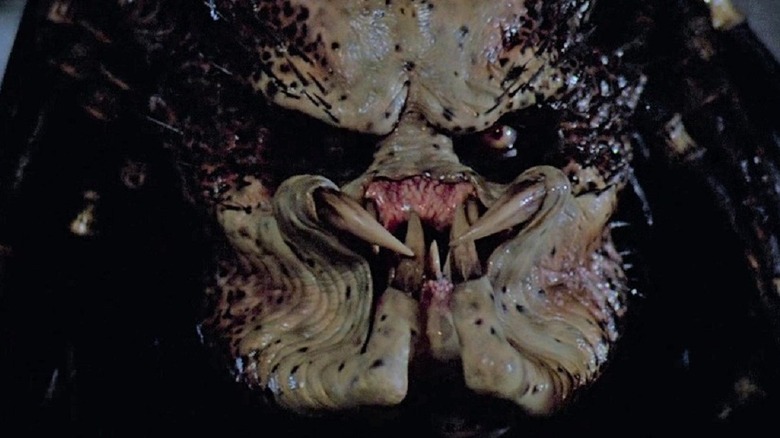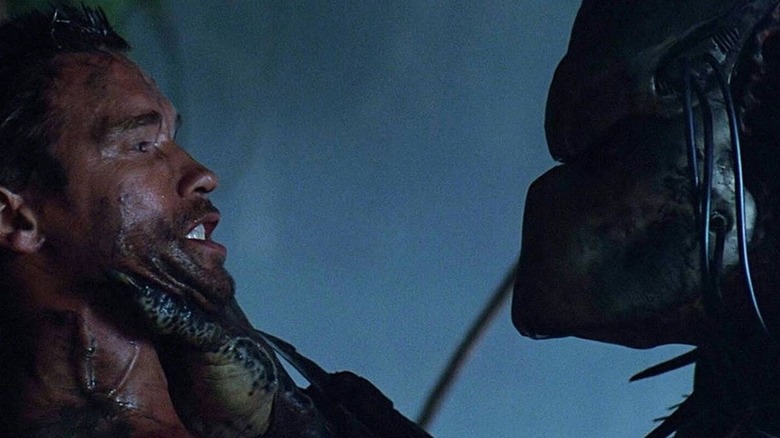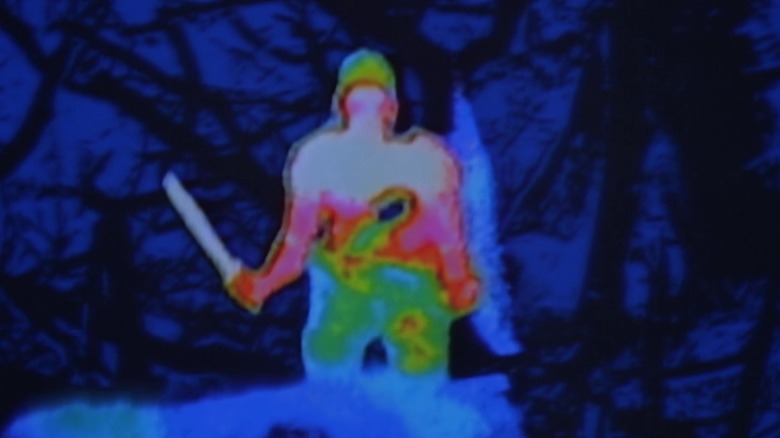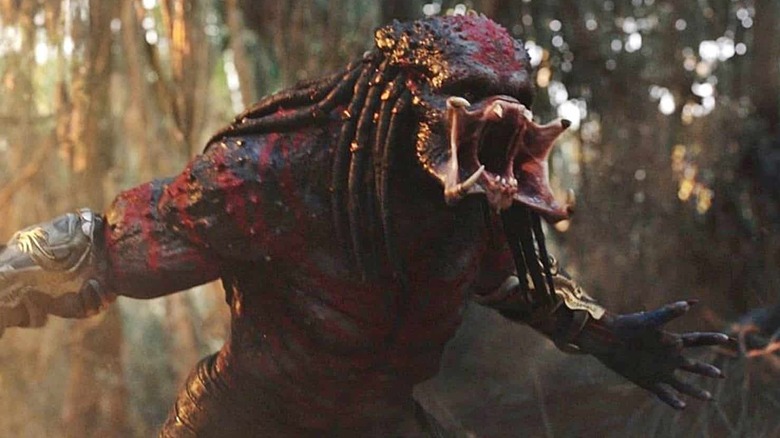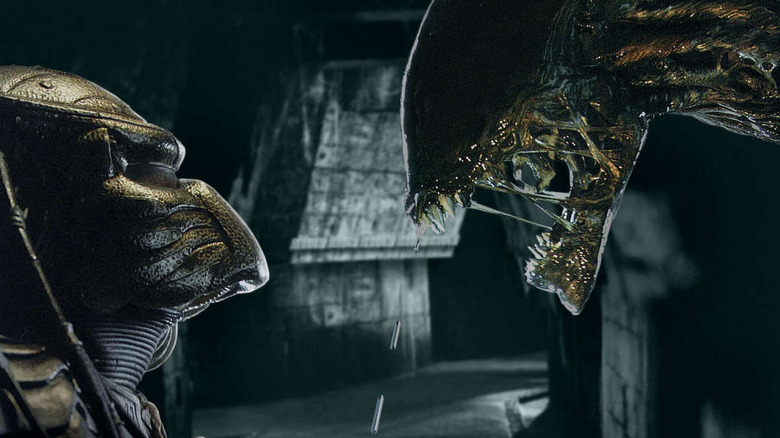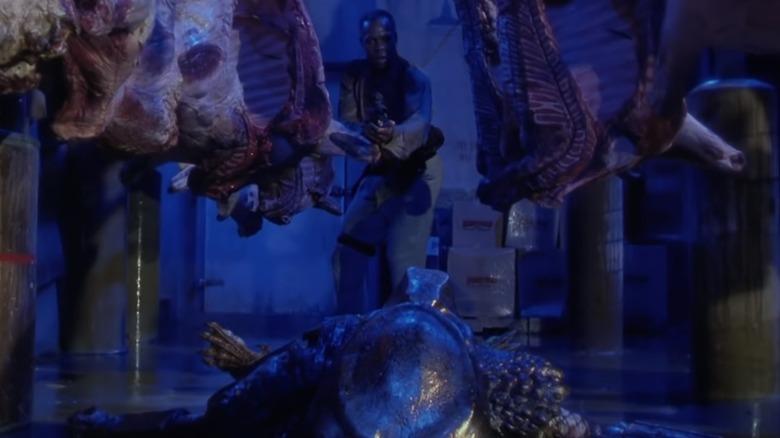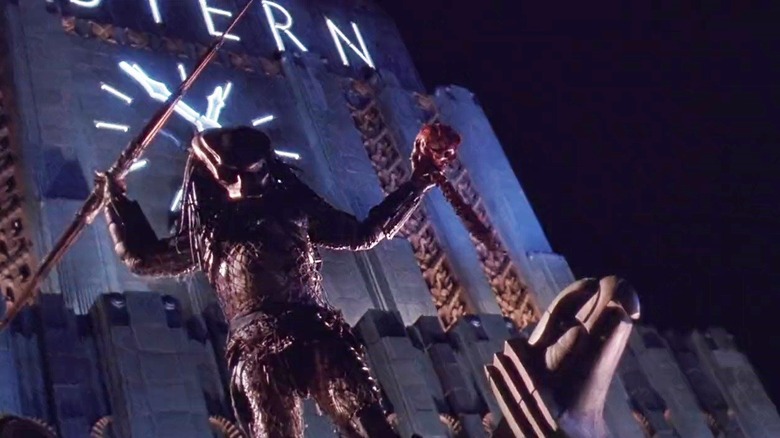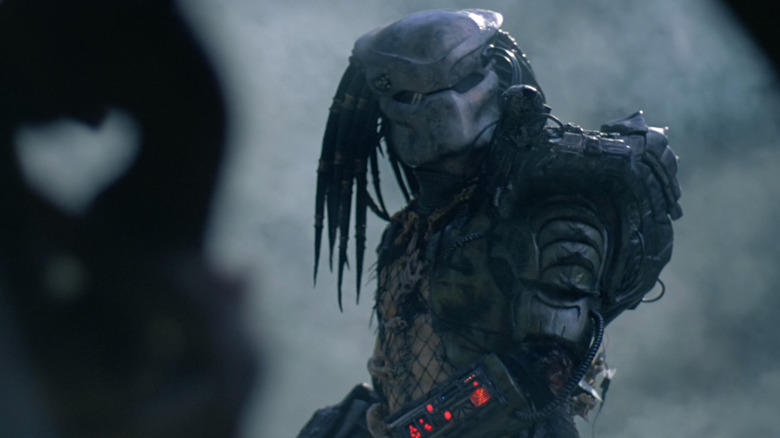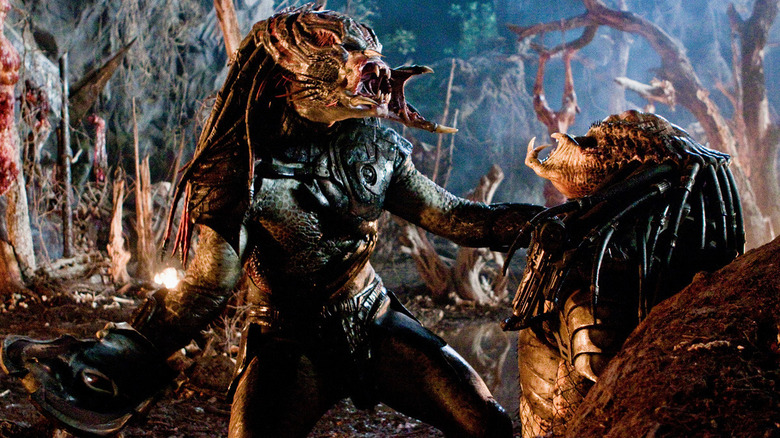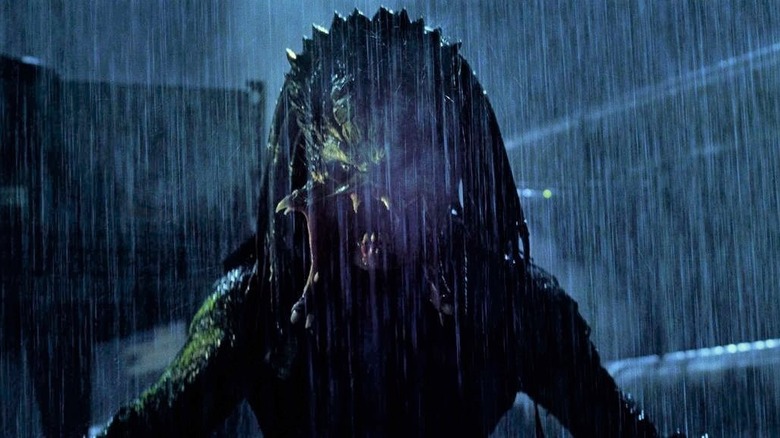False Facts About The Predator That Everyone Believes
When it comes to the movies, the "Predator" franchise is big on action and pretty light on lore. Fans of the "Predator" comics might call the race of creatures Yautja and have an idea what their homeworld is like, but for people who just follow the movies, all that really matters is that they're alien hunters who love killing humans and generally have an easy time doing so thanks to their personal cloaking technology and thermal vision.
So in the absence of lore in the movies, it's all too easy to make big assumptions about how it all works. In time, with the aid of the internet, those assumptions become accepted as facts, regardless of how little bearing they have on the movie canon. So let's correct the record. From the alien's true nature to the future of the franchise, here are facts about the "Predator" series that aren't really facts at all — they're just incorrect assumptions that a lot of fans continue to believe.
The Predator is a predator
To begin with, one thing to know about Predators is that they're not really predators. It sounds confusing, but it's true. It's even pointed out directly by the biologist Casey Bracket (Olivia Munn) in "The Predator." After all, while "Predator" is a great name for a movie about an alien who comes to Earth just to kill people, that doesn't mean it's technically accurate as a label for the creature.
In the natural world, a predator is a creature that kills another organism for food. That last bit is important. Predators (as in actual Earth animals in nature) kill because they need to eat. In contrast, the Predators who appear in the sci-fi franchise of the same name kill for sport or to prove their own prowess as hunters (something that appears to be highly valued in their culture). The Predators don't eat their kills — they just skin them, hang them upside down, and sometimes remove their skulls and spines to wave around triumphantly. They don't want meat; they want trophies. By definition, they're not predators. That said, we're still going to call them Predators (with a capital "P") for the sake of clarity.
They see in infrared
Particularly with the first and most beloved film in the series, some of the franchise's most iconic imagery comes from the Predator's point of view, showing Schwarzenegger and other cast members in bright colors that represent the intensity of their body heat as the creature hunts them through the dense jungle. This has led some viewers to mistakenly think that the Predator species has actually evolved to see with thermal imaging. If you pay attention, however, it becomes pretty clear that this infrared imaging is technological and contained in the lenses of the Predators' masks.
In "Predator 2," the extraterrestrial hunter has multiple vision modes he can switch between. And while we never see that happen in the original film, it's hard to deny that the otherworldly villain here must have other forms of vision as well. For example, how could he so easily avoid all the traps set for him by the commandos if all he can see is heat (which those traps wouldn't give off)? Plus, in the fantastic scene where he first takes his mask off, we watch as his vision completely changes, with the infrared disappearing from sight.
The franchise has been rebooted
It's not just the Predators who die and are replaced for every movie. Of the six "Predator" films released to date (counting the two "AVP" movies, which maybe we shouldn't, but we'll get to that), not a single installment features a returning human character from a previous movie. After more than three decades of that same formula, it starts to look like none of the movies are really connected at all. The two most recent installments in particular seem to bear the hallmarks of franchise reboots. "Predators" – spoiler alert — moves the action from Earth to an alien planet, while "The Predator" has a new military-based story and a title distinguished from the first movie only by the article "the."
Of course, this isn't the case for either sci-fi flick. Leaving aside the more complicated "AVP" installments, each "Predator" movie establishes that the previous films did indeed happen, even if the events have been classified so that most people don't know about them. In "Predator 2," government agent Peter Keyes (Gary Busey) discusses the events of the first movie. In "Predators," the character of Isabelle (Alice Braga) recognizes the Predators from a description of the events of the original "Predator." In "The Predator," the events of the first two movies are discussed and further confirmed as real by the presence of Sean Keyes, the son of Peter Keyes from "Predator 2," who's played by Gary Busey's actual son, Jake.
They exist in the same universe as the Xenomorphs from Alien
Let's talk about those "AVP" movies. "Alien vs. Predator" came out in 2004, and it was followed by "Alien vs. Predator: Requiem" in 2007. While the first "AVP" took place in a secret compound in Antarctica where the Predators hunt Xenomorphs in a controlled environment (of course, things fall apart over the course of the movie), "Requiem" featured Predators hunting an escaped hybrid "Predalien" and several Xenomorphs through a small Colorado town. Both films feature hints at the future of the "Alien" movies, with the second one in particular showing a left-behind piece of Predator technology falling into the hands of the Yutani Corporation, which will one day be a part of the "Alien" franchise's all-encompassing Weiland-Yutani company.
The plan, according to the directors of "Alien vs. Predator: Requiem," was to use a third movie to tie the events of the "AVP" movies directly into the original "Alien," bringing things full circle as Weiland-Yutani use Predator technology to develop the means of space travel that leads to the existence of ships like the Nostromo, which then encounters the Xenomorph in "Alien." That plan changed when original "Alien" director, Ridley Scott, returned to the franchise. He made his own prequel, "Prometheus," which led directly into "Alien: Covenant." These films are completely separate from the "AVP" history, with no signs that either the development of Weiland-Yutani or humanity's history with extraterrestrial beings resemble anything from those films. So whatever the case might be with the somewhat looser "Predator" continuity, it's very clear at this point that the Xenomorphs of the "Alien" films exist in a different timeline from any Predator.
Dutch is the only human who could defeat a Predator in one-on-one combat
Whatever character he's playing, Arnold Schwarzenegger tends to be regarded as the ultimate badass – and not without reason. His godlike physique and apparent strength have placed him on a level above other action heroes, especially in the 1980s, when superhero physiques weren't as widespread in movies as they've become in the era of cinematic super beings and human growth hormone in which we now find ourselves. So it makes perfect sense when Schwarzenegger's Dutch survives the deaths of his teammates in "Predator" and has a final showdown with the alien creature all on his own. He's basically Earth's champion in that moment, and he's fighting for us all.
But contrary to what you might think, he's not the only human to defeat a Predator in single combat. In "Predator 2," Danny Glover's Mike Harrigan single-handedly takes down a Predator of his own, and his win might've been even more impressive (the other Predators certainly seemed to think so). After the death of Peter Keyes, who thought he had the Predator's number and was quickly proven wrong, Harrigan and the titular alien are swiftly separated from Keyes' government allies, who might've otherwise intervened. However, Harrigan manages to sever one of the creature's arms, robbing it of its self-destruct mechanism. He then follows the Predator into an underground spaceship and beheads it with its own blade. Other Predators appear and carry off the dead body, then their leader honors Harrigan's prowess by giving him an antique gun that it had apparently taken on a previous hunt.
Predator 2 is a terrible movie
Few sequels are as commonly maligned as "Predator 2." It came in fourth at the box office on its opening weekend, was critically panned, and later installments in the franchise were celebrated for ignoring it. It's not a classic like its predecessor, and there's a good chance you haven't even seen it. If that's the case, go watch "Predator 2" and decide for yourself ... because it actually has a lot going for it.
It's a clear and deliberate departure from the first movie, but that's a better choice than trying to duplicate the original. "Predator" had jungle action pretty well-covered, so "Predator 2" brought its titular alien hunter to the streets of downtown Los Angeles. What's more, it's a near-future Los Angeles (the movie came out in 1990 but takes place in 1997), in which gangs rule the city, cops barely stand a chance, and everybody's guns still shoot bullets but they're weirdly big and chunky-looking. The aforementioned Danny Glover is the hero, as different from Arnold Schwarzenegger as an action star could be. Bill Paxton is also there, bringing the same big weird energy he had in "Aliens" to the role of a sleazy but ultimately heroic cop in Glover's squad.
Some of the depictions of criminals of color haven't aged great, but that's true of most action movie of this era, and at least this one has a Black hero. In fact, it's ultimately Danny Glover's performance, as a detective who simply won't quit no matter what he's up against, that makes "Predator 2" something of an underrated gem.
Predators need their masks to breathe on Earth
As part of the gadget-filled techno-armor they prefer to wear when hunting humans, each Predator has a metal face mask that they generally don't lose until the final showdown, when it's time to give the heroes and the audience a good look at that creepy mandibled face. Because Predators show up to Earth wearing this mask and don't usually take it off until shortly before they die, a lot of people assume that the mask is what enables them to breathe in Earth's atmosphere. If you pay attention, however, that's clearly not the case.
The first Predator does without a mask for a long time while fighting Dutch in the jungle, and he seems to breathe just fine. In "Predator 2," the creature is seen breathing through another device after losing his mask, but we don't know exactly why. Maybe Los Angeles' famous smog is too much for him. This same movie establishes that Predators breathe the same air as humans, however, because Harrigan can breathe inside their spaceship, even when interacting with an unmasked extraterrestrial. The same thing is true of the alien planet in "Predators" — the humans can breathe there just fine, and so can the unmasked hunters.
There's no doubt the mask provides copious tools to aid a Predator's survival — starting with that famous thermal vision — but a breathing apparatus is not one of them.
Predators all follow the same code of conduct
Most Predators seem to hunt by a code of honor: Don't kill anyone who's unarmed or pregnant, and respect your opponent. Those ideas are important to the first two "Predator" movies and even to the "AVP" films. In the two most recent installments, however, some new breeds of Predators show up, and they're just big mean jerks.
"Predators" features bigger, meaner Predators who are implied to be a different clan from the ones we've met before. They even have a "classic" Predator tied up in their camp to drive home the contrast. These extra-large Predators are still looking for a good hunt, but they don't seem to care about who's armed or anything like that. They'll kill you no matter what you're up to.
And the first beast to show up in "The Predator" is a classic model, but he's quickly hunted down and killed by a bigger, more powerful Predator. Unrelated to the bigger clan from "Predators," this creature has gained his power from hybridizing his own DNA to incorporate other species' powers and abilities. He also doesn't seem to care about rules. He just wants to kill and, in time, to conquer.
We've seen the last of the Predator
Released in 2018, "The Predator" was only a middling success at the box office, and it was widely panned by critics. These days, however, it takes a lot more than a bad installment or two to kill a sci-fi action franchise. Like the Predators themselves, the franchise just keeps getting up and coming for its prey (in this case, moviegoers). In fact, the next movie is already in production.
Currently called "Skulls" (but likely to be retitled something with the word "Predator" in it before release), the upcoming installment will star Amber Midthunder of "Legion" fame as a Comanche woman who wants to be warrior and who eventually encounters a Predator in the 19th century. "10 Cloverfield Lane" director Dan Trachtenberg is helming the movie, so it should at least be interesting.
And if it doesn't work, that will be disappointing, but it still won't be the end. The Predators will keep returning their favorite hunting grown: Earth's movie screens.
